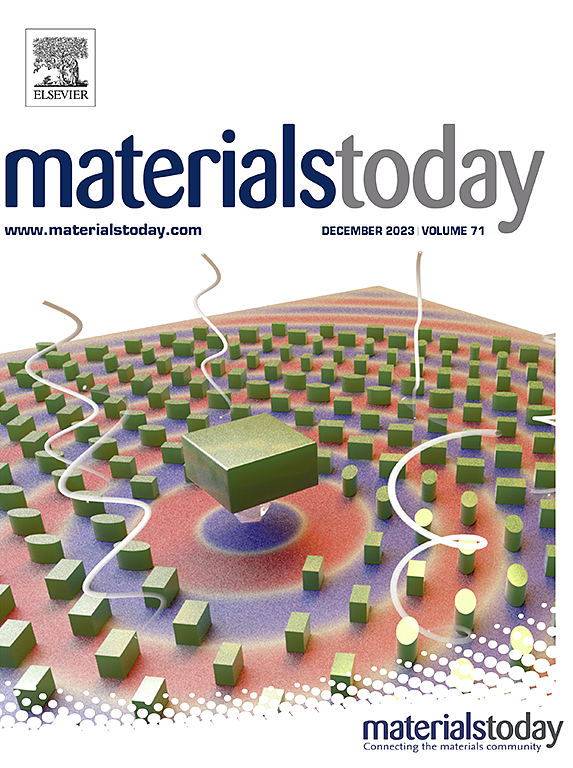s型光催化剂中的量子点
IF 21.1
1区 材料科学
Q1 MATERIALS SCIENCE, MULTIDISCIPLINARY
引用次数: 0
摘要
光催化材料在缓解能源短缺、治理环境污染等方面具有广阔的应用前景。s型光催化剂由于其独特的电荷转移机制而获得了广泛的关注,这使得其具有优异的光催化性能。许多基于量子点的材料已经被制备出来并应用于S-scheme光催化系统中。然而,缺乏对该领域当前进展的全面分析。为了解决这一问题,本文综述了基于qds的S-scheme光催化剂的最新研究进展。首先,简要回顾了s-图式异质结的发展和量子点的起源,然后讨论了利用量子点构建s-图式光催化剂的优势,以及合成量子点和基于量子点的s-图式光催化剂的常用策略。深入讨论了基于量子点的S-scheme异质结材料的光催化性能和机理,强调了量子点和S-scheme界面电荷转移过程的关键作用。迄今为止,各种组成的半导体量子点(如金属硫化物/氧化物、石墨碳氮化物、钙钛矿和黑磷)已被探索作为s -图式异质结的还原或氧化光催化剂。此外,贵金属、Ti3C2和碳量子点也被用作s型光催化剂的助催化剂。最后,对基于qds的s型光催化剂的进一步研究方向进行了展望。本文的研究成果有望促进s型光催化剂的进一步探索和开发,为其潜在的突破和应用铺平道路。本文章由计算机程序翻译,如有差异,请以英文原文为准。

Quantum dots in S-scheme photocatalysts
Photocatalytic materials hold bright prospect in alleviating energy shortage and remediating environmental pollution. S-scheme photocatalysts have garnered extensive attention because of their distinct charge transfer mechanisms, which lead to their superior photocatalytic performances. Numerous materials based on quantum dots (QDs) have been fabricated and applied in S-scheme photocatalytic systems. However, a comprehensive analysis of current advancements in this field is lacking. To address this gap, this review summarizes the state-of-the-art progress of QDs-based S-scheme photocatalysts. First, the development of S-scheme heterojunctions and origin of QDs are concisely retrospected, followed by a discussion about the advantages of employing QDs to build S-scheme photocatalysts and the common strategies to synthesize QDs and QDs-based S-scheme photocatalysts. The photocatalytic performance and mechanisms of QDs-based S-scheme heterojunction materials are thoroughly discussed, highlighting the key roles of QDs and the S-scheme interfacial charge transfer process. To date, semiconductor QDs of various compositions (e.g., metal sulfides/oxides, graphitic carbon nitride, perovskites, and black phosphorus) have been explored as reduction or oxidation photocatalysts in S-scheme heterojunctions. Moreover, noble metal, Ti3C2, and carbon QDs have been used as cocatalysts for S-scheme photocatalysts. Finally, future directions for the further exploration of QDs-based S-scheme photocatalysts are proposed. This review is expected to stimulate further exploration and development of S-scheme photocatalysts, paving the way for potential breakthroughs and applications.
求助全文
通过发布文献求助,成功后即可免费获取论文全文。
去求助
来源期刊

Materials Today
工程技术-材料科学:综合
CiteScore
36.30
自引率
1.20%
发文量
237
审稿时长
23 days
期刊介绍:
Materials Today is the leading journal in the Materials Today family, focusing on the latest and most impactful work in the materials science community. With a reputation for excellence in news and reviews, the journal has now expanded its coverage to include original research and aims to be at the forefront of the field.
We welcome comprehensive articles, short communications, and review articles from established leaders in the rapidly evolving fields of materials science and related disciplines. We strive to provide authors with rigorous peer review, fast publication, and maximum exposure for their work. While we only accept the most significant manuscripts, our speedy evaluation process ensures that there are no unnecessary publication delays.
 求助内容:
求助内容: 应助结果提醒方式:
应助结果提醒方式:


